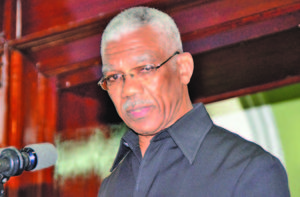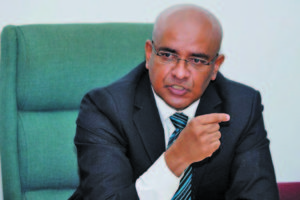Not only has Guyana’s economic growth rate for the last financial year been poor, it has proved to be extremely disappointing, as the economy has been in a bad state especially over the past three years ever since the coalition took over Government from the People’s Progressive Party/Civic(PPP/C).


This point was underscored by Opposition Leader and PPP General Secretary Bharrat Jagdeo, who recently criticised the David Granger-led Government for a lack of policies to support growth, both at the national and regional levels.
Citing the recent statements made by the President about the need to attract investment, Jagdeo, a trained economist, stated that “if there is no vision, then there won’t be any growth”.
The former Head of State said Granger continued to “walk in the clouds”, especially given the statement he made in reference to urging people to be innovative and to get out of the mind-set of mining and producing raw materials only when there is clearly no sound policies to help nurture and support this ‘so-called’ vision.
Jagdeo was referring to statements made by the President at the recent Linden Exhibition & Trade Fair.
Instead of presenting a thought-out approach that could result in greater progress for Lindeners, Jagdeo observed that the President instead went to the event with more platitudes.
He said the 2.1 per cent dismal growth rate gave a clear picture of how incompetent the current Government was at managing the financial and economic affairs of the country.
Jagdeo said the economic growth figure was low by all standards, and was in no way lending to the growth and development that were required in the country. He also reminded that the Government had to revise the growth projection three times, and that called into question its presentations to Parliament regarding the economy.
“So now that it is low, all of the ratios they spoke to us about in the last budget in November would have to be recalibrated. And so the size of our fiscal deficit would climb, our balance of payments in relation to [Gross Domestic Production] GDP will climb et cetera … rather than the Minister of Finance (Winston Jordan) seriously addressing the issues to say what policy-wise can I do to stimulate the economy, he then makes excuses,” he added.
The PPP General Secretary has also taken note of the Government’s intention to collectively borrow approximately G$220 billion (the Guyana Sugar Corporation (GuySuCo) bond of G$30 billion and the Islamic Development Bank loan of US$900 million) which he described as ‘shocking and cause for worry’.
Borrowing
According to the Opposition Leader, “This failed approach to national economic management was tried in the past. It led to a bankrupt country and resulted in devastating consequences for our people. I am sure everyone would recall that the external debt was over 900 per cent of GDP in 1992, which was reduced to 36 per cent of GDP in 2015.”
He said the PPP had predicted that this Government would go this route, since “the massive growth in the size of the national budgets, primarily on consumption, could not be financed by the hefty increase in taxation, so this hopelessly-misguided [A Partnership for National Unity] APNU Government had to resort to large-scale borrowing.”
With Guyana’s growth rate regressing, the Private Sector Commission (PSC) recently stepped up and compiled a report detailing several recommendations to put the country on a path to greater economic growth. The PSC’s “Action plan for the sustainable development of Guyana” report was handed over to Jagdeo and the Government.
An Inter-American Development Bank (IDB)-funded quarterly Labour Force Survey done during the period July to September 2017 has revealed that the unemployment rate for persons aged 15 and above was 12 per cent. In addition, the situation for women was found to be substantially worse than that for men.
The survey was done on a total population of 550,831 persons aged 15 years and above, with some 72.2 per cent living in urban areas. Given these figures, only 271,068 persons comprised the total employed population during the time of the quarterly survey – 166,873 males and 104,195 females. Urban workers totalled 188,774, while their rural counterparts numbered 82,294.
Close to 7000 sugar workers were fired by Government last year.



